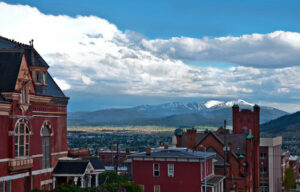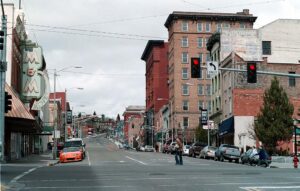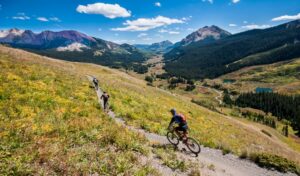Welcome to Butte, America.
Sure, it’s located in the state of Montana, but its civic identity is best described as Butte, America. And we mean that in the most literal sense: the moniker shows up on license plates, in advertising and even PBS documentaries. While the rest of the state brands itself with the usual themes of national parks, Hollywood movies and the Big Sky Country, there sits the contrarian stalwart known as Butte, America.

What’s In a Name?
As with most cities in the United States, Butte has a few nicknames associated with it. Because of its historical place in the mining industry, nicknames such as “The Richest Hill on Earth” and “The Mining City” are commonly used to refer to this little town nestled on the Continental Divide. For locals though, it isn’t just some historic mining city in Montana. It’s a city that requires no state following its name.
It’s uncertain where Butte’s abbreviated name originated, but it has been in use since the 1980’s, if not earlier. In his book, Butte Trivia, George Everett writes “the phrase was conceived by college students in Missoula as an insult and embraced by Butte residents as an apt description of their locale.”
Butte residents, for their part, tended to be immigrants still adapting and adjusting to their new American identity. In the words of historian David Emmons, “People in Butte never thought of themselves as Montanans. They identified first with Butte and then with places overseas – the countries they came from or other places where copper was mined.”

Butte Pride
Given how diverse Butte’s community is, the moniker still holds strong in the present day. Talk to any Butte native for 5 minutes and you’ll notice quickly how its residents still identify with Butte first. The pride has been passed down for generations, down to Butte’s early days as a mining town.
Its heritage stems from a melting pot of cultures attracted to the town during the rise of the copper industry in the 1800s. With immigrants arriving from China, Ireland, Lebanon, Austria, Italy, Mexico, and more, Butte became home to a community of tough, spirited, and solidarity-minded individuals. In fact, these solidarity-minded attitudes continues to live on for the residents of Butte. It exists on those proudly wearing “Butte vs Everybody” apparel or from those shouting exclamations of “Butte Tough!” in athletics. With so much pride surrounding the city, its name should stand out as the one and only Butte, America.
Butte Miners: Originators of “Butte Tough”
Given its vague origin, it seems that the name was either an insult or a point of pride. Or maybe a little of both. Considering that flipping insults into compliments characterize the city’s defiant survival instinct, the name becomes even apter.
In its heyday, thousands of miners worked up to a mile underground at a given time, around the clock. Take a minute to consider how dangerous this working environment was. Far under the ground, in unforgiving conditions, these men would spend hours hard rock mining with just each other to watch their backs. The lone way back up to the surface was possible only through personnel elevators that could carry a limited amount of people at a time. Even those with the strongest survival skills could fall to the unpredictable nature of mining underground.

The limited mode of transportation to the surface was no more apparent than during the 1917 Granite Mountain mine disaster. This tragedy exacted the largest death toll in U.S. hard rock mining history. When a lantern started a fire a half-mile underground, most of the 168 fatalities succumbed to asphyxia before they could escape to the surface.
All those man-hours of underground toil and sacrifice weren’t for nothing, however. Producing copper ore, the mines here literally connected America to itself and the rest of the world. During the nationwide buildout of electricity and telecommunications, Butte mining produced up to 20% of all domestic copper.
Birth of a Daredevil
That bare-knuckle determination reincarnated itself in Butte’s native son, Evel Knievel. The daredevil racked up 433 bone fractures from his record-breaking motorcycle jumps.
In true Butte form, Knievel made speeches to his audience after his many jumps while frequently injured and bleeding profusely, just before being whisked to the hospital in an ambulance. When his doctors were warning him that he might not walk again, Knievel was plotting his next spectacular stunt, done while festooned in his signature red, white and blue jumpsuit.
If that’s not Butte, America, I don’t know what is.
Butte marches to its own drum compared to other cities in Montana. Spend time here and you will see why. Built on a hillside, locals use the term ‘uptown’ to the office district most cities would consider downtown. Instead of offering the usual fare like pizza and burritos, restaurants advertise pasties and breaded pork chop sandwiches. Even the language is localized, with colloquial speech including the plural ‘you’ pronounced as “you’s.”
It’s a relic of the American melting pot of days past, in constant reinvention on its own terms.




